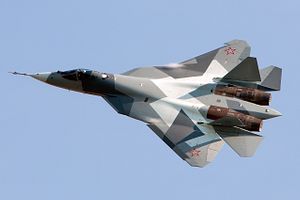Russia’s first indigenously designed and built fifth-generation stealth fighter, the Su-57, conducted its first flight with a new jet engine, according to a source in Russian Ministry of Industry and Trade.
“Russia’s newest fifth generation fighter, T-50, performed its maiden flight with the second stage engine on December 5, 2017, at the Gromov Flight Research Institute,” the source told TASS news agency in Moscow on Tuesday.
The test flight lasted 17 minutes. The Su-57 is a multirole, single seat, twin-engine air superiority/deep air support fighter intended to replace the Russian Aerospace Force’s aging fleet of MiG-29s and Su-27s in the coming years. Once operational, it would be the first fifth-generation stealth fighter in service in the Russian military.
Russian Industry and Trade Minister Denis Manturov said that the successful flight “will give an additional boost to the fifth-generation fighter jet program… This proves the high potential of the Russian aircraft industry, capable of designing smart and advanced systems – aerodynamic systems, innovative digital components, newest engines.”
As I explained previously, the engine remains one of the major technical weaknesses of the Su-57 program casting into doubt whether the aircraft is truly a fifth-generation fighter jet: “As of now, Su-57 prototypes are equipped with a derivative of the Saturn AL-41F1S engine, dubbed AL-41F1, an engine also installed on the Sukhoi Su-35S Flanker-E.”
The new engine— the next-generation Saturn izdeliye 30 — will reportedly not be ready for serial production until 2020. “The Saturn izdeliye 30 will feature increased thrust and fuel efficiency and is also expected to improve the fighter jet’s stealth characteristics given the use of new composite materials,” I wrote in August.
Russia currently operates nine Su-57 prototypes with two additional aircraft expected to be delivered to the Russian Aerospace Force by the end of the 2017. So far, hundreds of test flights with the prototypes have taken place. However, experimental design work on the Su-57 is not expected to be completed until 2019.
The aircraft is also slated to enter serial production the same year.
The Su-57 will be capable of carrying some of Russia’s most advanced weapons systems including new beyond-visual-range air-to-air missiles and air-to-ground missiles including the extended range Kh-35UE tactical cruise missile as well as the nuclear-capable BrahMos-A supersonic cruise missile.
However, the price for carrying such a heavy weapons load will likely be reduced stealth capabilities, as I pointed out previously: “Both the BrahMos-A and KH-35UE do not fit into the aircraft’s internal weapon bay and consequently will need to be carried under the aircraft’s wings in a transport launch canister, which will reduce the fighter jet’s stealthiness.”
Meanwhile, a joint India-Russia defense project based on the Su-57, the co-development and production of the Sukhoi/HAL Fifth Generation Fighter Aircraft (FGFA), also known in India as the Perspective Multi-role Fighter (PMF), continues to show little sign of progress with New Delhi allegedly wanting to cancel the program in its entirety.
































